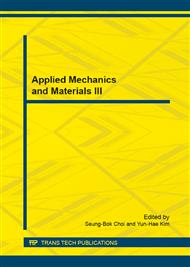[1]
Wang J H, Chen C F, Ho J R, et al. One step fabrication of surfaces relief diffusers by stress-induced undulations on elastomer. Optics & Laser Technology, 2009, 41: 804-808.
DOI: 10.1016/j.optlastec.2008.12.005
Google Scholar
[2]
YC Li and C L Chen, A novel single-stage high-power-factor AC-to-DC LED Driving circuit with leakage inductance energy recycling, IEEE Trans. Ind. Electron., 2012, 59: 793–802.
DOI: 10.1109/tie.2011.2151817
Google Scholar
[3]
Szymanski Lukasz, Surolia Praveen, Byrne Owen, et al. Porous sponge-like, anatase TiO2 via polymer templates: Synthesis, characterization, and performance as a light-scattering material. Colloid and Polymer Science, 2013, 291: 805-815.
DOI: 10.1007/s00396-012-2792-x
Google Scholar
[4]
Son Suim, Hwang Sun Hye1, Kim Chanhoi, et al. Designed synthesis of SiO2/TiO2 core/shell structure as light scattering material for highly efficient dye-sensitized solar cells. ACS Appl. Mater. Interfaces, 2013, 5 (11): 4815–4820.
DOI: 10.1021/am400441v
Google Scholar
[5]
Ma Wenshi, Zhang Dongqiao, Duan Yu, et al. Preparation, characterization of monodisperse polysiloxane microspheres and its application as light scattering agents. Gaofenzi Cailiao Kexue Yu Gongcheng/Polymeric Materials Science and Engineering, 2012, 28( 8): 129-132.
Google Scholar
[6]
Chenyun Zhang, Shengnan Zhang, Picheng Gao, et al. Superhydrophobic hybrid films prepared from silica nanoparticles and ionic liquids via layer-by-layer self-assembly. Thin Solid Films, 2014 (570): 27-32.
DOI: 10.1016/j.tsf.2014.08.045
Google Scholar
[7]
G. Decher, J. Maclennan, U. Sohling, J. Reibel. Creation and structural comparison of ultrathin film assemblies: transferred freely suspended films and Langmuir–Blodgett films of liquid crystals, Thin Solid Films 1992 (210): 504-507.
DOI: 10.1016/0040-6090(92)90325-6
Google Scholar
[8]
G. Decher, Fuzzy nanoassemblies: toward layered polymeric multicomposites, Science 1997 (277): 1232-1237.
DOI: 10.1126/science.277.5330.1232
Google Scholar
[9]
E. Kharlampieva, S.A. Sukhishvili, Hydrogen-bonded layer-by-layer films, J. Macromol. Sci. Polym. Rev. 2006 (46): 377-395.
DOI: 10.1080/15583720600945386
Google Scholar


